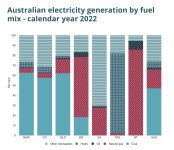jonescg
100 MW
I know you're playing games here, but for the benefit of a casual reader:
All electricity generated is consumed as it is created. Rooftop PV, wind farms, gas peaker plants - if it's on the grid it's delivering power somewhere like water finding the lowest point.
Whether it's consumed by the house the panels are installed upon, or consumed down the street, or consumed at the other end of an interconnector - all energy generated is consumed, not spilled or vented. Even pumped hydro and battery storage are simply calculated as a demand on the grid.
We know there are half a million rooftop solar systems in Western Australia of about 7 kW each. We know the insolation each day and we know the efficiency of the systems. We can calculate the energy delivered to the grid, and this is seen as a reduction in thermal generation in the middle of the day. Hell, Western Power can integrate the reactive power on the grid and determine to within 5% the exact amount of rooftop PV at any instant. If all that PV was doing nothing, why are we seeing system demand drop to under 500 MW in the middle of the day? That PV is being consumed everywhere, at all times, on the grid, including at the end of a public charge point.
As for CPOs selling 100% renewable energy, we all know it's an accounting exercise, but they have power purchase agreements from large scale RE generators. As long as the energy consumed through all of their chargers is less than or equal to the energy purchased by the generators, they can lay claim to 100% RE on their network. But if they sell more power than they bought, they will need to buy more, and that justified the construction of new RE generation.
All electricity generated is consumed as it is created. Rooftop PV, wind farms, gas peaker plants - if it's on the grid it's delivering power somewhere like water finding the lowest point.
Whether it's consumed by the house the panels are installed upon, or consumed down the street, or consumed at the other end of an interconnector - all energy generated is consumed, not spilled or vented. Even pumped hydro and battery storage are simply calculated as a demand on the grid.
We know there are half a million rooftop solar systems in Western Australia of about 7 kW each. We know the insolation each day and we know the efficiency of the systems. We can calculate the energy delivered to the grid, and this is seen as a reduction in thermal generation in the middle of the day. Hell, Western Power can integrate the reactive power on the grid and determine to within 5% the exact amount of rooftop PV at any instant. If all that PV was doing nothing, why are we seeing system demand drop to under 500 MW in the middle of the day? That PV is being consumed everywhere, at all times, on the grid, including at the end of a public charge point.
As for CPOs selling 100% renewable energy, we all know it's an accounting exercise, but they have power purchase agreements from large scale RE generators. As long as the energy consumed through all of their chargers is less than or equal to the energy purchased by the generators, they can lay claim to 100% RE on their network. But if they sell more power than they bought, they will need to buy more, and that justified the construction of new RE generation.


